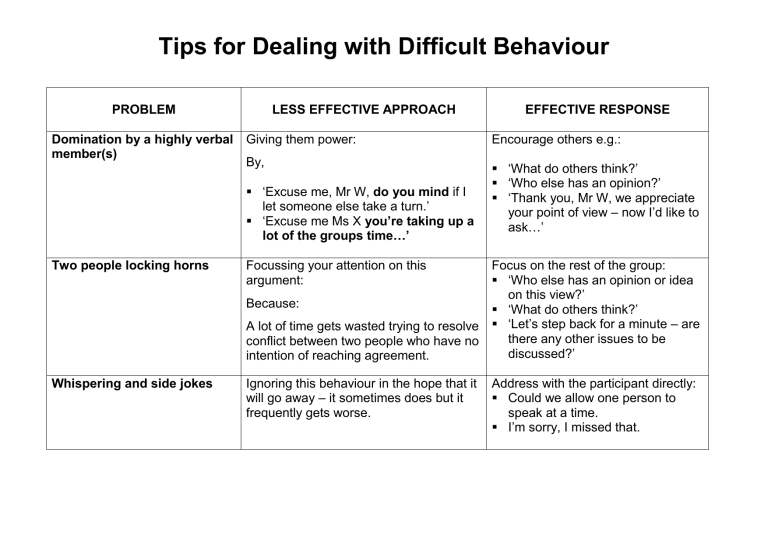Tips for Dealing with Difficult Behaviour
advertisement

Tips for Dealing with Difficult Behaviour PROBLEM Domination by a highly verbal member(s) LESS EFFECTIVE APPROACH Giving them power: Encourage others e.g.: By, ‘What do others think?’ ‘Who else has an opinion?’ ‘Thank you, Mr W, we appreciate your point of view – now I’d like to ask…’ ‘Excuse me, Mr W, do you mind if I let someone else take a turn.’ ‘Excuse me Ms X you’re taking up a lot of the groups time…’ Two people locking horns Focussing your attention on this argument: Because: A lot of time gets wasted trying to resolve conflict between two people who have no intention of reaching agreement. Whispering and side jokes EFFECTIVE RESPONSE Ignoring this behaviour in the hope that it will go away – it sometimes does but it frequently gets worse. Focus on the rest of the group: ‘Who else has an opinion or idea on this view?’ ‘What do others think?’ ‘Let’s step back for a minute – are there any other issues to be discussed?’ Address with the participant directly: Could we allow one person to speak at a time. I’m sorry, I missed that. Tips for Dealing with Difficult Behaviour PROBLEM LESS EFFECTIVE APPROACH EFFECTIVE RESPONSE Someone becomes loud and repetitive Ignore them and draw out people’s ideas who sound the most promising. Failure to start on time Waiting too long for participants. Summarise the persons view, repeat back and move on. That’s an interesting point. Thank you for that contribution and move on. In terms of Team around the Child Meetings, if a family member is late please wait but discuss the time limit with participants as to how long to wait. The advertised finish time drifts by with no sign of the end in sight Going overtime without asking. If anyone has to leave they tiptoe out. Check out at the beginning of the meeting, if anyone has a deadline and make sure they speak early. One or two silent members in Act as though silence signifies agreement You could say: a group where other members with what’s been said. ‘I’d like to get opinions from those participate actively who haven’t talked for a while.’ Ignore them and be thankful they’re not ‘Let’s hear from someone else making trouble. who hasn’t spoken for a while.’ ‘Who else would like to speak?’ Tips for Dealing with Difficult Behaviour PROBLEM LESS EFFECTIVE APPROACH EFFECTIVE RESPONSE More time is spent on trivial items and less time on important ones (i.e. red herring) No agenda at all: everything and anything Set an agenda. State and restate being discussed. clearly the reason for the meeting and items to be discussed. The same people come to all the meetings even if it not clear why they or their department need to be represented. Conversely people who really should be there are never invited. Lets invite everyone and have a good old Keep meeting small to people who professionals chit-chatter with no can provide a service. Keep agenda, agreed actions or review date. focussed on the needs of the family. People make promises they don’t keep: ‘leave that one to me, I’ll do that.’ Can be said out of pressure to contribute without any real understanding of commitment, availability of resources & time etc. Summarise what was agreed. Ensure action points are based on SMART outcomes. Link action directly to defined need.


